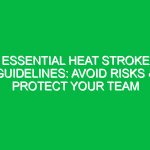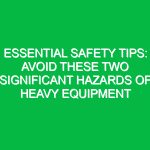“`html
Essential Heavy Equipment Safety: Avoid These Four Other Hazards
Introduction
Good morning team,
Today, we’re going to dive into a crucial topic that affects each one of us—heavy equipment safety. The objective of this Toolbox Talk is to highlight essential safety practices and focus on four specific hazards that we need to avoid when operating heavy machinery. Understanding these hazards is not just important for compliance; it’s vital for safeguarding our lives and the lives of our coworkers.
Heavy equipment is an integral part of our daily operations, but with its use comes significant risks. By taking the necessary Precautions and understanding these hazards, we can create a safer work Environment for everyone.
Understanding Heavy Equipment Safety
Heavy equipment safety encompasses the practices, procedures, and regulations that ensure the safe Operation of machinery such as bulldozers, excavators, and cranes. The importance of heavy equipment safety cannot be overstated; it directly impacts our productivity and well-being.
Common misconceptions include the belief that accidents only happen to inexperienced operators. In reality, even seasoned professionals can encounter dangerous situations if they become complacent or overlook safety protocols.
Key Hazards, Risks, and Safety Considerations
Let’s discuss the four specific hazards we must avoid:
- 1. Poor Visibility: Operating heavy machinery in low-light conditions or without clear sightlines can lead to severe accidents.
- 2. Mechanical Failures: Equipment that isn’t properly maintained can fail, leading to accidents and injuries.
- 3. Overloading Equipment: Exceeding the weight capacity of machinery can cause tipping or mechanical breakdowns.
- 4. Inadequate Training: Without proper training, operators may not understand how to handle equipment safely, increasing the risk of incidents.
Ignoring these hazards can lead to catastrophic consequences, including severe injuries or fatalities. It’s imperative that we remain vigilant and proactive in identifying and mitigating these risks.
Best Practices, Procedures, & Actionable Advice
How can we ensure safety when operating heavy equipment? Here are some Best Practices:
- Conduct Regular Inspections: Before using any heavy machinery, perform thorough inspections to check for mechanical issues. Look for leaks, worn-out parts, and ensure all safety devices are functional.
- Ensure Clear Visibility: Always operate machinery in well-lit conditions. Use spotters or cameras if visibility is compromised to maintain awareness of your surroundings.
- Follow Weight Limits: Always adhere to the manufacturer’s weight specifications. This not only protects the equipment but also ensures your safety.
- Engage in Continuous Training: Attend regular training sessions to stay updated on safety protocols and Best Practices. Consider simulations or hands-on training to reinforce learning.
For example, in a recent incident at our site, a crane operator failed to notice a low-hanging beam due to poor visibility, leading to damage and downtime. This could have been avoided with proper Safety Measures.
Regulations, Standards, and Compliance
Compliance with safety regulations is not optional; it’s a requirement under OSHA and other relevant safety Standards. These regulations are designed to protect workers from the hazards associated with heavy equipment.
Understanding these regulations helps ensure that we are not only compliant but also contributing to a culture of safety within our organization. Remember, safety regulations are in place to protect us; ignoring them could lead to serious consequences.
Employee Engagement & Discussion
Let’s open the floor for discussion. What safety challenges have you encountered related to heavy equipment operation? Are there specific practices that you think we could improve upon? Your feedback is invaluable in creating a safer workplace.
Conclusion & Key Takeaways
To summarize, adhering to essential heavy equipment safety practices is crucial for avoiding hazards that could lead to accidents. Remember to:
- Conduct regular inspections.
- Ensure visibility is clear.
- Follow weight limits.
- Engage in ongoing training.
Let’s commit to applying these practices daily to maintain a safe work environment. Thank you for your attention and for your commitment to safety. Together, we can make our workplace safer for everyone.
“`


